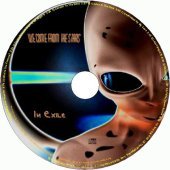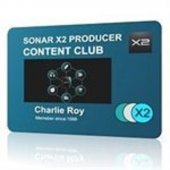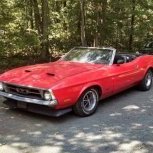-
Posts
4,436 -
Joined
-
Last visited
-
Days Won
5
David Baay last won the day on March 9
David Baay had the most liked content!
Reputation
2,179 ExcellentRecent Profile Visitors
4,685 profile views
-

Problems with delay per articulation feature.
David Baay replied to Nigel Simmons's topic in Cakewalk Sonar
What's the exact scenario (i.e. what delay values, what tempo, where does the switch occur, and where are notes relative to the articulation start/end points). Maybe share a simple demo project. I once had a project that exhibited a change in note volume related to an issue with articulation delays, but I reported it, and the problemis no longer reproducible in in the current release. Possibly you've encountered another manifestation of that problem. -

External Insert and Graphics Issues in Sonar
David Baay replied to Tommy Byrnes's topic in Cakewalk Sonar
I guess it could depend on what else is going on in the project in the way of PDC and overall processing load but I definitely have not seen anything like that, even with a 2048-sample buffer at 48kHz. -

External Insert and Graphics Issues in Sonar
David Baay replied to Tommy Byrnes's topic in Cakewalk Sonar
Are you sure about the length of that delay? I think the gap that Noel is talking about is more on the order of an audio buffer or two - maybe 50-100ms if you're running a large buffer. The gap I get is like that - a small fraction of a second. -
Yes, definitely 20-40% better. ;^)
-
The CbB screenshot is showing "X-AIR ASIO Driver" while the Sonar screenshot is not showing "ASIO". Possibly you have the drive mode set to WDM or WASAPI...?
-

External Insert and Graphics Issues in Sonar
David Baay replied to Tommy Byrnes's topic in Cakewalk Sonar
Is CbB still giving expected results with the same project in both cases? Sonar has revised External Insert functionality that now supports using mono channels of a stero pair independently among other things, but I've not seen any issues with it except in very esoteric use cases (e.g. putting two mono external inserts in series using channels of the same stereo pair which - not entirely unexpectedly - causes PDC issues). I don't often have enough tracks in the Console view to have to do a lot of scrolling but I can't say I've ever seen that issue. -
FWIW - I'm running a i7-3770 @ 3.4GHz... I've now got 32GB ram, but was running on 16GB for years. I'm typically use an ASIO buffer size of 64 Likewise here on a 10-year-old i7 6700k @ 4.0Ghz with 24GB. It continues to run great for my purposes - admittedly using a generally limited number of synths and FX plugins compared to what some users require. But running more plugins just requires raising the ASIO buffer. 8GB would already have been considered somewhat marginal even in the Sonar 8 era, but is no more limiting now than it would have been then. If it's possble to double it, that would be advisable.
-
The longest audio file I have handy is two hours and 15 minutes. I just opened the project over WiFi from another PC where it's saved, figuring that would be worst-case. It took some time to draw the waveform, but even before that completed paging back and forth by measures was instantaneous as expected. So unless the audio has to be a lot more than two hours to demonstrate the issue, whatever is happening seems to be peculiar to your system or Sonar configuration. You might try turning off/disabling your interface to see if it has something to do with Sonar's interaction with the audio driver.
-
Preview files are per-project but do not have the same kind of internal file association and path encoded in the project file as a normal audio file (that's why you can delete them without Sonar complaining when the project is still open). So the only way Sonar 'knows' that a preview file belongs to a particular project is to save it in a dedicated project folder. Therefore it can't/won't write a preview file to the global Audio Data folder. Sonar never automatically deletes an audio file once a project has been saved with a track referencing it at any point. That's why Clean Audio Folder and CWAF exist. Automatic clean-up only happens if you close a project without saving the session in which the file was created.
-
Project preview files are handled differently; they need to persist in order for preview to work so they don't require re-saving the project. I'm pretty sure this is working as designed. Also, I did a quick test, closing without saving after bouncing an instrument track with nothing else in a new project, and the two preview files were created as expectedand persisted after closing both the project and Sonar.
-
Those files are used by the Project Preview function of the Start Screen. Per the documentation they are created by default the first time you export; it doesn't mention bouncing, but Export and Bounce use the same code. This default preview creation will only happen once and the two files will initially have the same content; after that, the file with the longer name will be replaced with a copy of the exported/bounced file only if you pro-actively check the "Include Project Preview' box in the Mix and Render section. I'm not sure why, exactly, but the file with the shorter name seems to be kept indefinitely as an archive of the first export/bounce you perform while the file with the longer name will be the one that plays when you click the Project Preview playback. It's been requested previously to have control over the maximum length of the preview file as this can get to be an issue for users who work with hours-long recordings. For typical song-length projects, the extra space used isn't a huge deal, but I would probably opt to limit previews to 30 seconds myself, and not have one created by default.
-
Yes, clearly an issue with buffering the 130 (!) active lanes of MIDI on Track 4, compounded by all the split and slip-edited clips. Apply Trimming pretty much eliminates the issue. If you were to simply disable Non-Destructive MIDI Editing, I think you would not encounter this issue. Having it enabled means you effectively double the number of MIDI events that Sonar has to manage every time you split a clip.
-

Recording MIDI CC events on separate tracks or take lanes, possible?
David Baay replied to Billy86's topic in Cakewalk Sonar
You can do this with lanes of an Instrument track but when lanes are not showing, Sonar stacks the clips in the parent track rather than merging their content, and the order in which clips are stacked (i.e. what's on top) can be unpredictable/uncontrollable. When using MIDI lanes, I generally leave the lanes showing so it's clear what's in each lane, and what's soloed/muted. I have previously requested that Sonar visually merge MIDI clips in lanes (and scale them all the same) when lanes are not showing. -

Difference between stereo bus and aux.
David Baay replied to MarkSound's topic in Cakewalk by BandLab
Some other differences: - Input to an Aux track is determined by its Input assignment (a Patch Point) and which tracks/buses are outputting/sending to the assigned Patch Point. - Input to a Bus is determined only by the Output/Send assignments of other tracks and buses (notwithstanding that both tracks and buses can get input from plugins in the FX bin). - Aux tracks have a Phase controls that buses do not. - Buses have Input Pan that Aux tracks do not (allowing you to alter panning ahead of the FX bin) - [Input] Gain on Aux tracks can add up to 18dB, Input Gain on Buses can add only 6dB. - Buses have a Waveform Preview function that can be toggled on/off, similar to the "confidence recording" trace shown on armed tracks during recording. -
Rather than starting a new project from the template and trying to re-save that over the template, you need to open the template file directly and re-save after modification. It's always worked this way. EDIT: Oops, majorly misread that post, though you made it quite clear it was about Track Manager Presets. Carry on.













